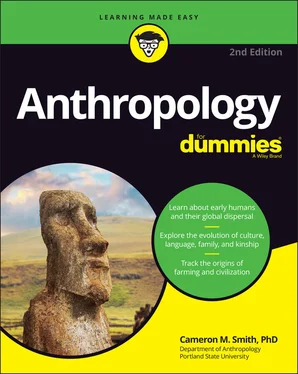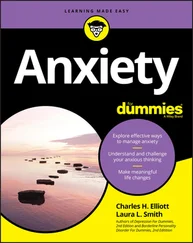Enter anthropology , the scientific study of humanity. In this book I tell you what you need to know about anthropology, what anthropologists have discovered about humanity, and what anthropologists mean when they say that there are “many ways of being human.” I also tell you how anthropology works, and what anthropologists have learned about humanity, both modern and ancient. You’ll see that in a century or so of study, anthropology has helped to answer some of humanity’s fundamental questions about itself.
And knowing ourselves is important if, as a species, we want to make good decisions about our present and future. Biologically, humanity needs to know itself if it’s going to make good decisions about everything from gene therapy to genetically engineered food crops; that knowledge comes from anthropology. And culturally, knowledge of our past helps us understand what we are today, for better and worse; we did not just pop up out of nowhere. We have a long and complex evolutionary history that can help us understand what we are at the moment. In Part 1of this book — specifically in Chapters 2and 3— you find out how anthropology studies humanity from these biological and cultural perspectives. In Part 4of this book, you see how anthropology helps humanity to deal with some real, real-world problems.
Digging Into Anthropology’s History
For a long time the answers to profound questions about humanity came largely from religious texts. For example, when European explorers realized that the New World wasn’t India, the Native Americans — millions of people nobody was expecting to find — were explained from a biblical perspective as remnants of the lost tribes of Israel.
But since the late 19th century AD another perspective has emerged, the scientific study of humanity called anthropology. At first, anthropology was a quaint and pretty simple affair, studied as a hobby by all kinds of Naturalists and pseudoscientists. But when people started to realize how much anthropology could teach humanity about itself, they began to take it more seriously. Anthropology became a science, the science of humanity at large.
In Chapter 2, you can explore anthropology’s history and how it changed over time from being a pseudoscience to today’s highly technical study of human DNA, ancient fossils, the evolution of the mind, and how cultures change through time. In Chapter 3, you can find more detail about how anthropology has developed over time, affecting how it goes about learning about humanity in the first place.
 The questions that anthropologists have asked (and ask today) are in part a reflection of the times. For example, today a lot of people are investigating the effects of climate change on ancient human populations. This isn’t to say that climate change isn’t an issue today, but we should be careful with projecting our anxieties on the past. Knowing the potential for bias, anthropologists are careful about making assumptions. My mentor, professor Ken Ames, taught me a great lesson, early in my grad-school career: Be most skeptical of your favorite hypothesis. I try to remember that advice any time I think I have something figured out!
The questions that anthropologists have asked (and ask today) are in part a reflection of the times. For example, today a lot of people are investigating the effects of climate change on ancient human populations. This isn’t to say that climate change isn’t an issue today, but we should be careful with projecting our anxieties on the past. Knowing the potential for bias, anthropologists are careful about making assumptions. My mentor, professor Ken Ames, taught me a great lesson, early in my grad-school career: Be most skeptical of your favorite hypothesis. I try to remember that advice any time I think I have something figured out!
Getting Acquainted with Anthropology’s Subfields
Anthropology has a complex, colorful, and sometimes checkered history. As you find out in Chapter 2, the field has gone through several transformations, and today there are more ways of doing anthropology than you can shake a stick at.
Now, the study of humanity is a vast undertaking, so anthropologists have divvied up the task into four main subfields:
Physical anthropology: Humanity as a biological species
Archaeology: Humanity’s deep past
Cultural anthropology: Humanity’s current behavioral diversity
Linguistics: Humanity’s unique mode of communication
As you study anthropology, keep in mind that to really understand humanity, anthropologists need to know at least a little about each of the subfields. For example, an archaeologist studying an ancient civilization needs to know what a physical anthropologist has to say about that people’s bones, because the bones can tell us what people ate or how they practiced medicine. And today, cultural anthropologists can’t know much about a culture unless they have a good knowledge of that culture’s language, requiring some familiarity with linguistic anthropology.
Physical differences between groups of humans are easily visible; mainland Europeans tend to be lighter-skinned with straight hair, and folks from Africa are typically darker-skinned with curlier hair. These are biological differences, and the goal of physical anthropology (sometimes known as biological anthropology ) — the study of humanity as a biological species — is to understand how and why these variations on the human theme came about. Physical differences among living humans aren’t all that physical anthropology is concerned with, but understanding human variation (especially genetic differences) worldwide and through time is an important part of the field.
In Part 2of this book, I boil down the main discoveries of physical anthropology to date so that what’s left is the skeleton, the essentials. This material is what physical anthropologists know today and a little about what they’re studying and hoping to learn in the future. Chapter 4introduces you to the primate order, your home in the animal kingdom. Chapters 6and 7take you to Africa, the cradle of humanity, to cover the fossil (and some DNA) evidence of human evolution.
Like all anthropology, physical anthropology has its fingers in a lot of different pies, from the study of fossils, to DNA analysis, documenting and explaining differences in cold- or heat-tolerance among people worldwide, the study of disease, population genetics, and a dozen other topics. Chapter 19introduces you to the cutting edge study of physical anthropology, focusing on the magnificent molecule called DNA.
It’s hard to get to know someone without knowing a little about their past, and the same goes for humanity; a lot of what we do today — good and bad — is based on the acts and decisions of our ancestors. To understand humanity any further than skin deep requires looking into the past. This is the business of archaeologists.
But the past can be foggy (on a good day) because history — the written record — can only take us so far (and if you believe everything written in the ancient historical texts, well, I’ve got some oceanfront property in Utah you may be interested in). However well-meaning they may have been, historians have had their biases like everyone else. And, of course, the ancient historians didn’t write down everything, especially if they were unaware of, say, the entire Western Hemisphere (North and South America, also sometimes known as the “New World”).
Archaeologists are the people who try to fill in the gaps of history by studying the material remains of ancient cultures. It’s archaeologists who get excited over discovering an ancient piece of pottery, not necessarily for that piece of pottery alone (though it may be beautiful) but because of what it can tell humanity about our past.
 Archaeologists don’t just focus on correcting or fleshing out the historical record; they also study the roughly 2.5 million years of humanity before writing was invented (which was only about 6,000 years ago).
Archaeologists don’t just focus on correcting or fleshing out the historical record; they also study the roughly 2.5 million years of humanity before writing was invented (which was only about 6,000 years ago).
Читать дальше

 The questions that anthropologists have asked (and ask today) are in part a reflection of the times. For example, today a lot of people are investigating the effects of climate change on ancient human populations. This isn’t to say that climate change isn’t an issue today, but we should be careful with projecting our anxieties on the past. Knowing the potential for bias, anthropologists are careful about making assumptions. My mentor, professor Ken Ames, taught me a great lesson, early in my grad-school career: Be most skeptical of your favorite hypothesis. I try to remember that advice any time I think I have something figured out!
The questions that anthropologists have asked (and ask today) are in part a reflection of the times. For example, today a lot of people are investigating the effects of climate change on ancient human populations. This isn’t to say that climate change isn’t an issue today, but we should be careful with projecting our anxieties on the past. Knowing the potential for bias, anthropologists are careful about making assumptions. My mentor, professor Ken Ames, taught me a great lesson, early in my grad-school career: Be most skeptical of your favorite hypothesis. I try to remember that advice any time I think I have something figured out!










